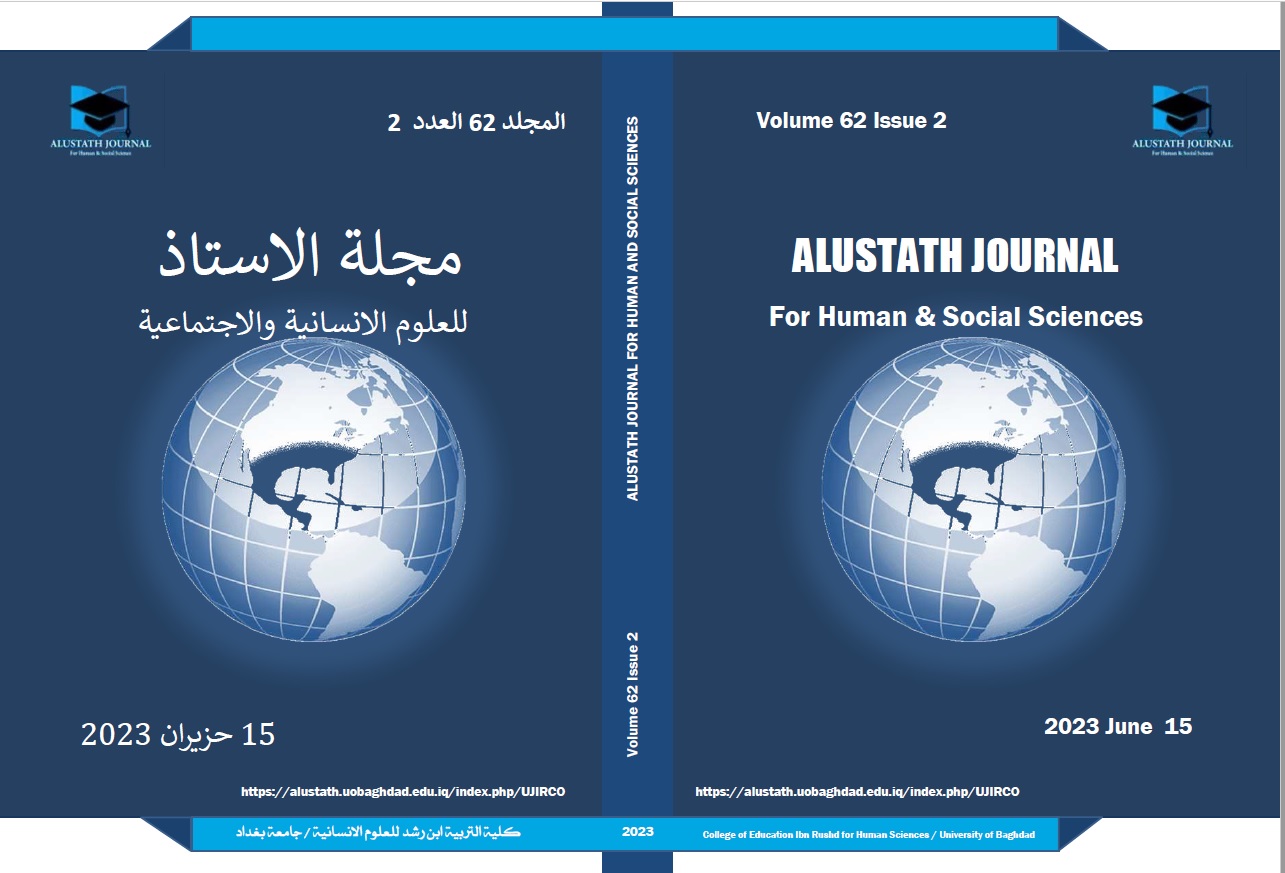Some of the Examples of Alfiat ibn Malik to Clarify the Grammatical Rules
DOI:
https://doi.org/10.36473/ujhss.v62i2.2021Keywords:
Explanatory examples , Ibn Malik , Alfiyah, clarification of the rule , SemanticityAbstract
The research paper studies some examples of Ibn Malik in his Alfiyah, which includes the basic rules of the grammatical chapters contained therein, and the topic under investigation is being manipulated by studying the examples of Ibn Malik in his brief summary to prove the essential grammatical rules and studying them semantically, and then relating that to what was mentioned in the grammatical books. Alfiyah commentators can make use of these examples in their explanations. The significance of this topic is due to the fact that it sheds light on an important topic, which is: studying the examples of Alfiyat ibn Malik grammatically and semantically. The research objectives endeavor to achieve revolves round: tackling examples of Alfiyat ibn Malik to prove the grammatical rule. According to the nature of the research, the descriptive approach was adopted; particularly analysis as one of its tools, and it is being restricted to Malik examples in terms of grammatical summary in order to be examined grammatically and semantically. The study was divided into two axes, the first one was concerned with introducing Ibn Malik and his Alfiyah, and the other was devoted to talking about the concept of examples, and studying some examples of Ibn Malik as a grammatical semantic study, and then a conclusion in which the most important findings and recommendations were mentioned.
Downloads
References
• The Holy Quran.
• Ahmed Tammam, the son of Malik, the owner of the millennium (2009 AD), Islam Online, archived from the original, 28 March.
• Al-Ashmouni, Abu Al-Hussein Nour Al-Din Ali bin Muhammad bins Issa Al-Ashmouni (1955 AD), Sharh Al-Ashmouni, investigation: Muhammad Muhyi Al-Din Abdul Hamid, 1st Edition, Dar Al-Kitab Al-Arabi, and Beirut, Lebanon.
• Al-Azhari, Sheikh Khaled (2006 AD) Explanation of the Declaration on Clarification, Investigation: Muhammad Basil Oyoun Al-Soud, 2nd Edition, Dar Al-Kutub Al-Ilmiyya, Beirut, Lebanon.
• Al-Hamawi, Shihab Al-Din Abu Abdullah Yaqout bin Abdullah (1993 AD) Dictionary of Countries, Dar Sader, Beirut.
• Al-Harbi, Abdul-Aziz bin Ali (1424 AH), the easy explanation of the millennium of Ibn Malik in grammar and morphology, Dar Ibn Hazm for Publishing and Distribution, Riyadh.
• Al-Jerjani, Ali bin Muhammad Al-Sayyid Al-Sharif (D. T.) Dictionary of Definitions, investigation and study: Muhammad Siddiq Al-Minshawi, Dar Al-Fadilah, Cairo.
• Al-Ketbi, Muhammad bin Shakir (1974 AD) Fatwas and the Tail on them, investigation: Ihsan Abbas - Dar Sader - Beirut, Lebanon.
• Al-Suyuti, Al-Hafiz Jalal Al-Din Abdul-Rahman Al-Suyuti (1964 AD) for the purpose of awareness in the layers of linguists and grammarians, achieved by Mumad Abu Al-Fadl Ibrahim, Issa Al-Babi Al-Halabi Press, Egypt.
• Al-Telmisani, Ahmed bin Muhammad Al-Maqri (1969 AD) The Good Breath of the Good Ghost of Andalusia, investigation: Ihsan Abbas, Dar Sader, Beirut.
• Al-Thanawy, Muhammad Ali (1996 AD) Scouting Art Conventions, investigation by: Rafiq Al-Ajam, and Ali Dahdouh, 1st Edition, Library of Lebanon.
• Anis, Ibrahim, and others (1392 AH) The intermediate dictionary, 2nd floor, House of Revival of Arab Heritage, Cairo.
• Dhaif, Shawqi (D.T) Evolution and Renewal in Umayyad Poetry, 8th Edition, Revised Edition, Dar Al Maaref, Egypt.
• Ibn Al-Anbari, Abu Al-Barakat (2002 AD) Equity in Dispute Issues, Investigation and Study: JudatMabrouk Muhammad, revised by, Dr. Ramadan Abdel-Tawab, 1st Edition, Al-Khanji Library, Cairo.
• Ibn al-Nazim, Abu Abdullah Badr al-Din Muhammad ibn al-Imam Jamal al-Din ibn Malik (2000 AD) Ibn al-Nazim’s explanation on the Alfiya of Ibn Malik, investigation: Muhammad Basil Oyoun al-Soud, 1, Dar al-Kutub al-Ilmiyya, Beirut, Lebanon.
• Ibn Aqil, Bahaa al-Din Abdullah bin Aqeel (1980 AD) Ibn Aqil’s explanation of the Alfiya of Ibn Malik, investigated by Muhammad Muhyi al-Din Abd al-Hamid, Dar al-Turath, Cairo.
• Ibn Hisham, Abu Muhammad Abdullah Jamal al-Din ibn Yusuf ibn Hisham (2004 AD) Explanation of the Roots of Gold in Knowing the Words of the Arabs, authored by: Muhammad Muhyi al-Din Abd al-Hamid, Dar al-Tala’i’, Cairo.
• Ibn Hisham, Abu Muhammad Jamal al-Din ibn Yusuf ibn Ahmad ibn Abdullah ibn Hisham al-Ansari (D.T) explained the paths to Alfiya Ibn Malik, authored by: Muhammad Muhyi al-Din Abd al-Hamid, the modern library, Sidon, Beirut.
• Ibn Malik, Muhammad bin Abdullah bin Malik Al-Andalusi (D.T) Text of the Millennium, Popular Library, Beirut, Lebanon.
• Ibn Manzoor (D.T) Lisan Al-Arab, investigation: Abdullah Ali Al-Kabeer, Muhammad Ahmed Hassaballah, and Hashem Muhammad Al-Shazly, a new verified Edition, Dar Al-Maaref, Cairo.
• Ibn Uthaymeen, Muhammad bin Saleh (1434 AH) Explanation of Alfiya Ibn Malik, 1st Edition, Al-Rushd Library Publishers, Riyadh.
• Muslim, Abu Al-Hussain Muslim bin Al-Hajjaj Al-Qushayri Al-Nisaburi (2006 AD) Sahih Muslim, investigation: Abu QutaibaNazar bin Muhammad Al-Faryabi, 1st Edition, Dar Taibah.
• Othman Muhammad bin Hassan (2004 AD) The Affiliate Guide in Shows and Rhymes, 1st Edition, Dar al-Kutub al-Ilmiyya, Beirut, Lebanon.












